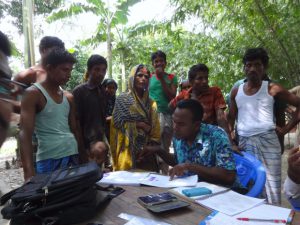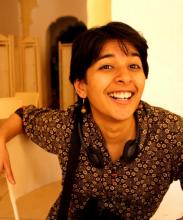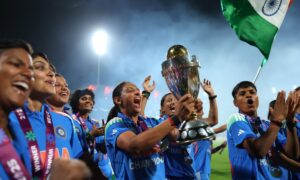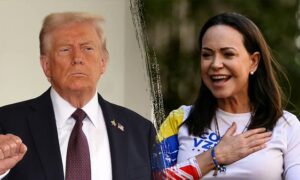
Figure 1: Survey team at the makeshift camp, surrounded by enclave residents who have come to verify their
names on the list and register their ‘choice’. Photo: Author
By Sahana Ghosh
Raj Kumar and his family were in great distress; their family was split on the decision of choosing a nationality. One of five Dalit households of the Rabidas caste in the Indian enclave of Banshpachai in Bangladesh’s Lalmonirhat district, they are a family of four brothers, the youngest still in high school. It is the muggy month of July in 2015 and the usually indistinguishable enclaves of India and Bangladesh are abuzz with activity.
Away from the glamour of the Dhaka Summit between Modi and Hasina earlier that year, an unprecedented process unfolded in northern Bengal: between July 6-16 2015, fifty teams of enumerators comprising government employees of India and Bangladesh were jointly managing a ten-day-long bureaucratic enterprise. Tasked with conducting a survey to verify residents and record their choice of nationality in the 111 Indian enclaves in Bangladesh, mirroring the work of twenty-five teams in the 51 Bangladeshi enclaves in India,[1] one such team had set up a camp in Banshpachai.[2] This short essay focuses ethnographic attention on the survey itself, foregrounding the contradictions and uncertainties that marked enclave residents’ experiences of the process. In doing so, it dwells on the silences and erasures that resound in the nationalist historical narratives that have emerged and gained hegemonic traction in both countries with regard to the exchange of enclaves and resolution of a ‘remarkable territorial anomaly’.[3] Historicizing the making of these enclaves and their continued life in South Asia, Willem van Schendel argues that ‘the contiguous, uninterrupted homeland is a fiction’ (van Schendel 2002). What then were the lived realities of enclave residents as they participated in this transformation of ‘sensitive space’ into territorial possessions (Cons 2012)?
While the official team went around the Banshpachai enclave door-to-door, most residents, Muslims and Hindus, registered their decision to stay on and assume Bangladeshi citizenship at the makeshift ‘camp’ set up in each enclave (see Figure 1). On the one hand, India’s ratification of the Land Boundary Agreement was being hailed in public discourse as a diplomatic victory for regional peace and cooperation, the long-awaited resolution of an immodern geo-political oddity;[4] on the other hand, the democratic settlement of the future citizenship of enclave residents was being celebrated by enclave residents’ organizations as a victory for their painstaking movement over several decades.[5] Between these two poles of jubilation that heralded freedom from ‘statelessness’ for thousands of enclave residents, 68 years after the rest of the subcontinent, the embrace of the nation-state seemed unquestionably welcome. What would a new and substantial citizenship mean in the lives of these Hindu and Muslim communities? How would their existing identities and attachments be altered and accommodated? When the survey team came knocking, what material futures were families choosing?
Away from the celebratory spotlights, these questions evoked profound existential philosophizing mixed with heartbreaking confusion and indecision for many that belied the straitjackets of nationalist frames. ‘How can I leave my birthplace? This is the only homeland I have known. This is Hindustan-Pakistan all over again,’ mused one elderly Muslim man in another Indian enclave in Bangladesh’s Kurigram district. Seated beside him in the shade of a jackfruit tree, his Hindu neighbor continued: ‘Since we have spent all our lives here, might as well wait for death here too. Though I sometimes do wonder how it would be to die on Bharat’s Hindu land. Then I remember; if I die there, my daughters [married into families outside the enclave in Bangladesh] won’t even be able to come see my corpse. What is the need?’ As families and neighbors gathered to dwell on the promises and consequences of the decision they had to take, unsurprisingly, references to the Partition of 1947 abounded as a comparable historical juncture, one that would influence the fate of generations, form and break communities. The ‘long shadow of partition’ (Butalia 2015) loomed over the conduct of the survey and the exchange of the enclaves; the governments of India and Bangladesh were understandably at pains to prevent two of the most catastrophic elements of that historical process: forced displacements and violence against religious minorities. Consequently, members of the religious minority like Raj Kumar in Bangladesh were of interest to both governments as became evident in the solicitous engagement of the enumerators as well as respective district officers in both countries. For India’s Narendra Modi-government, it was important to not be viewed as luring Hindus in this process even as it protectively tracked the welfare of the community in the neighboring countries. For Bangladesh, the secular credentials of the Sheikh Hasina-government were at stake and it was imperative to demonstrate that Hindu residents of the enclaves were under no threat to leave. However, consequently, the implicit strategy at play for both was to create conditions such that people would stay where they were.
Raj Kumar and his younger brother who work in manufacturing in Dhaka are keen to go to India but as one of them said, deeply troubled, ‘Our mother is not giving us permission to go.’ A widow, she lives in her paternal home in Kurigram district where the youngest brother goes to school. Their mud and thatched roof house in Banshpachai, outside which we were seated on this day in July 2015, remains locked for most of the time. Since the 2011 survey that conducted a census in all the enclaves, there had been steady rumors about an impending resolution, including the possibility of migrating to India permanently. With that desired future flashing before their eyes, however unknown, the brothers even decided against investing any money in renovating their dilapidated house. The two brothers had taken leave from their contractual job in a steel rod manufacturing company to be present in Banshpachai during the survey and arrive at a consensus within the family. With the leave and the survey nearing an end, Raj Kumar was beside himself with worry: to leave would mean veritable separation from his mother and two other brothers, while to stay could mean giving up an opportunity to become an Indian citizen, a status he has always imagined to be more valuable than that of being a Bangladeshi citizen.
But now that the he is forced to decide, he knows no more than his speculative dreams. Lowering his voice and leaning forward to me, as he learns I am an Indian citizen, he asks: “Tell me, didi, what will India give? What will I get there?” As the Indian government – and all members of the joint survey – remained tight-lipped on rehabilitation details, enclave residents were in the dark about what, materially and substantively speaking, they were choosing. This was not simply an unintended consequence of what was a bureaucratic process; it was an illusion of choice by design. Redrawing the map is easier than taking responsibility of people. The promised and democratically viable solution to this problem was “choice”: that people would get to choose where they wanted to live. However, pausing on the process that transpired we can see that instead of an informed choice, the risks of moving were made to seem so high that enclave residents, marginal farmers for the most part, were nudged into staying where they were due to the sheer lack of information about what would happen to them, their land, their livelihoods if they chose to leave.
As historian Vazira Zamindar has argued in her work, emphasizing on the long process that Partition was rather than a bounded cataclysmic event, the bureaucratic work of constructing categories of ‘citizen’ and ‘refugee’ out of divided families and regulating the movement and kin relations was a vital part of the violence of displacement and dispossession that Partition embodies (Zamindar 2007).
The joint India-Bangladesh bureaucratic enterprise of administering the selection of citizenship celebrated its cooperation, camaraderie, and democratic nature as a model of bilateralism in the region in assumed contradistinction to the hostilities between the governments of India and Pakistan that underlay the processes of state formation in the immediate aftermath of 1947 (Khan 2007). And no doubt the socio-cultural impact of this achievement is significant: Indian and Bangladeshi primary school teachers and district government officers spent ten days in their respective neighboring country, working with colleagues of that country, encountering local hospitality and lived realities that allowed them to form their own opinions of shared pasts and contemporary divergences well beyond popular stereotypes. However, beneath this remarkable exercise lurked a bureaucratic violence that could not be named in the mono-tuned media coverage nor narrated in the nationalist frames of determined bureaucratic and bilateral success.

Figure 2: A local journalist taking photographs of a Muslim family in the enclave who had been left out of the records based on a previous list from 2011, promising to use current public attention to put pressure on the governments to resolve the matter. Photo: Author
A lull in the afternoon by the Gotamari survey camp on another day is shaken up by a great hullaballoo as a team of observers arrived, tailed by a group of local journalists. The latter’s enthusiasm is soaring, their idealism unbridled. Pouncing on a middle-aged woman who is lurking around the survey table diffidently, they find out that she and her family had been left out of the 2011 survey of enclave residents on which the present rolls are based. Lining the family up to photograph them (see Figure 2), one journalist assures them that since all eyes are on them now, he is certain that the photograph in news media will have the power to attract attention to her problem and thereby find a resolution. ‘This is a historical moment,’ another journalist declares emphatically, ‘we are all lucky that we are a part of it’, addressing the rather subdued group of enclave residents that have gathered. As she is being photographed, the woman clutching on to her children, feebly says that she plans to stay in Bangladesh but is nevertheless worried about being left out of the record. The journalist has already bounded on to take an ‘action shot’ of another woman inking her thumbprint on to the survey rolls as the observers and gathered locals look on. As I spent the rest of day accompanying the observers, it became clear that they were concerned with the minutiae of the paperwork as well as the optics of the survey itself. While the documentary record must be immaculate to facilitate the emigration of people later that year and to prevent loopholes,[6] the interaction of the enumerators with enclave residents must also proceed in fine balance, combining information with discretion, kindness without pressures. Thus with the liberal, secular, democratic credentials of free and fair “choice” soundly protected and roundly exhibited by both governments, this business of determining citizenship could be concluded. In the enclaves, however, mixed feelings and profound confusion lingered in the air; these were to find little place in History, national and bilateral.

Figure 3: Visiting observers inspecting the survey records as the Indian and Bangladeshi enumerators look on nervously. Photo: Author
The complexities of gender rendered invisible in bureaucratic paperwork reared its head most prominently in the normative definition of the family, which was the primary unit upon which this whole enterprise of citizenship and population transfer was based. Having elected Indian citizenship at the very beginning of the two-week long camp, a Hindu family in Gotamari enclave was reconsidering the decision in the last few days. Their son-in-law, from a family in Gaibandha district, lived with them as a ghar-jamai. However, he neither featured on the 2011 survey list of residents nor could be added in to the present record as daughters and their families were not considered eligible as enclave residents unless they married into another enclave family in which case the daughter would be incorporated as a member of that family. So even though the daughter and her husband lived in the enclave, there was no way they could be considered a part of the family unit. There was a further complication. They had had a child in 2013 who, according to the guidelines for the 2015 exchange enrolment, could be included since she had been born in the enclave for which there was evidence in the form of a birth certificate. So the joint Hindu family was faced with the ‘choice’ of either leaving the daughter, ghar jamai and their child behind in Bangladesh as they became Indians and moved permanently across the border. Or they all decided to stay in Bangladesh even though they were emotionally invested in moving their lives and future to India. The enumerators were sympathetic but they declined to help since it was beyond what was permitted in the guidelines.
In much of the literature on partitions, be it in our subcontinent, in Palestine (Kanaaneh and Nusair 2010), or in numerous postcolonial African contexts (Malkki 1995), longing has mediated the relationship between home and belonging at individual and community scales. In this case of the India-Bangladesh enclaves, we find a peculiar iteration of longing: not in the form of nostalgia for a return to a place or past, but in the aspiration for an imagined time and place in the future. Most of those, especially Hindus, who elected to take on Indian nationality and move permanently once the Indian enclaves in Bangladesh cease to exist,[7]long for a land, a home that neither they nor their ancestors have never known. Will this imagined homeland and the nation-state of India be the same? With their journey across the border, ceremoniously welcomed and garlanded as midnight’s new children, will citizenship arrive fully formed in their lives? Two years since those journeys in 2015, today that is another emergent story of another long partition.
Endnotes
[1] ‘India, Bangladesh launch survey in enclaves over nationality’, Times of India.
[2] ‘Dhaka, Delhi jointly launch survey in 162 enclaves’, Daily Star.
[3] ‘Marooned by history in India and Bangladesh’, NYTimes. For a fine ethnography of life, belonging, and territorial nationalism in the largest Bangladeshi enclave, see Jason Cons, 2016, Sensitive Space: Fragmented Territory at the India-Bangladesh border, Seattle: University of Washington Press.
[4] ‘Breakthrough in India-Bangladesh ties’, The Hindu.
[5] ‘Bhatrigachhi enclave gets a nation, but the flag will fly at half-mast’, Livemint.
[6] A total of 987 residents eventually emigrated to India from the Indian enclaves in Bangladesh, including a few from the Gotamari enclave. See, ‘63 enclave residents leave Bangladesh for India’, The Independent.
[7] No residents of the Bangladeshi enclaves in India elected to move to Bangladesh.
Works Cited
Butalia, Urvashi, ed.
2015 Partition: The Long Shadow. New Delhi: Zubaan/Penguin.
Cons, Jason
2012 “Histories of Belonging(s): Narrating Territory, Possession, and Dispossession at the India-Bangladesh Border.” Modern Asian Studies 46(03): 527–558.
Kanaaneh, Rhoda Ann, and Isis Nusair
2010 Displaced at Home: Ethnicity and Gender among Palestinians in Israel. SUNY Press.
Khan, Yasmin
2007 The Great Partition: The Making of India and Pakistan. New Haven: Yale University Press.
Malkki, Liisa H
1995 Purity and Exile: Violence, Memory, and National Cosmology among Hutu Refugees in Tanzania. Chicago: University of Chicago Press.
van Schendel, Willem
2002 “Stateless in South Asia: The Making of the India-Bangladesh Enclaves.” The Journal of Asian Studies 61(1): 115–147.
Zamindar, Vazira Fazila-Yacoobali
2007 The Long Partition and the Making of Modern South Asia: Refugees, Boundaries, Histories. Columbia University Press.

Bio: Sahana Ghosh is completing a PhD in Anthropology and Women’s, Gender and Sexuality Studies at Yale University. Her research is on the increasing militarization of the India-Bangladesh border and the everyday realities of regional geopolitics, transnational mobility and economy in these agrarian borderlands in both countries. Her writing has been published in the Himal, Economic and Political Weekly, and Contemporary South Asia among others.
The post first appeared on Cafe Dissensus.


















